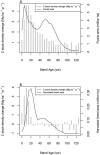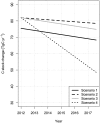Complex forest dynamics indicate potential for slowing carbon accumulation in the southeastern United States
- PMID: 25614123
- PMCID: PMC4303866
- DOI: 10.1038/srep08002
Complex forest dynamics indicate potential for slowing carbon accumulation in the southeastern United States
Abstract
Over the past century forest regrowth in Europe and North America expanded forest carbon (C) sinks and offset C emissions but future C accumulation is uncertain. Policy makers need insights into forest C dynamics as they anticipate emissions futures and goals. We used land use and forest inventory data to estimate how forest C dynamics have changed in the southeastern United States and attribute changes to land use, management, and disturbance causes. From 2007-2012, forests yielded a net sink of C because of net land use change (+6.48 Tg C yr(-1)) and net biomass accumulation (+75.4 Tg C yr(-1)). Forests disturbed by weather, insect/disease, and fire show dampened yet positive forest C changes (+1.56, +1.4, +5.48 Tg C yr(-1), respectively). Forest cutting caused net decreases in C (-76.7 Tg C yr(-1)) but was offset by forest growth (+143.77 Tg C yr(-1)). Forest growth rates depend on age or stage of development and projected C stock changes indicate a gradual slowing of carbon accumulation with anticipated forest aging (a reduction of 9.5% over the next five years). Additionally, small shifts in land use transitions consistent with economic futures resulted in a 40.6% decrease in C accumulation.
Figures




References
-
- Pan Y. et al. 2011. A large and persistent carbon sink in the world's forests. Science 333, 988–993 (2011). - PubMed
-
- Mather A. S. The forest transition. Area. 24(4), 367–379 (1992).
-
- Casperson J. P. et al. Contributions of land-use to carbon accumulation in U.S. forests. Science. 290(5494), 1148–1151 (2000). - PubMed
MeSH terms
Substances
LinkOut - more resources
Full Text Sources
Other Literature Sources
Miscellaneous

